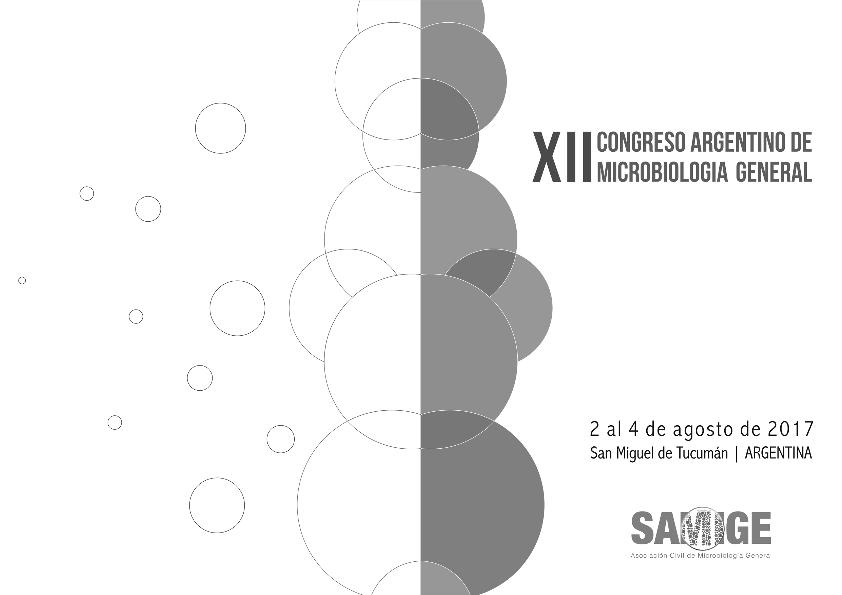Evento
Optimal conditions for the preservation of Pseudomonas tolaasii iexb, a microorganism used as grass biofertilizer
Lobo, Constanza Belén ; Juárez Tomás, María Silvina
; Juárez Tomás, María Silvina ; Ferrero, Marcela Alejandra
; Ferrero, Marcela Alejandra ; Lucca, Maria Ester
; Lucca, Maria Ester
 ; Juárez Tomás, María Silvina
; Juárez Tomás, María Silvina ; Ferrero, Marcela Alejandra
; Ferrero, Marcela Alejandra ; Lucca, Maria Ester
; Lucca, Maria Ester
Tipo del evento:
Congreso
Nombre del evento:
XII Congreso Argentino de Microbiología General
Fecha del evento:
02/08/2017
Institución Organizadora:
Asociación Argentina de Microbiología;
Título del Libro:
XII Congreso Argentino de Microbiología General
Editorial:
Asociación Argentina de Microbiología
Idioma:
Inglés
Clasificación temática:
Resumen
Phosphorus (P) is one of the most required inorganic nutrient for microorganisms and plants. Phosphate Solubilizing Bacteria (PSB) exert a relevant role in the P cycle on the soil, mobilizing deposits of insoluble phosphates. PSB belong to the group of Plant Growth Promotion Rhizobacteria (PGPR). In previous studies, PSB were isolated from Argentinian Puna (Salta and Jujuy) and characterized for their ability to solubilize tricalcium phosphate and hydroxyapatite. Other properties of PGPR were also evaluated, such as indole acetic acid and siderophore production, and ability to biocontrol against phytopathogen fungi. Pseudomonas tolaasii IEXb was selected for its ability to promote the plant growth and to increase performance of maize culture. The aim of this work was to evaluate different preservation treatments of P. tolaasii IEXb biomass, to formulate a product with shelf life according to its application on field. Biomass production was performed in a 10 L fermenter (New Brunswick Scientific Microferm Fermentor MF-214), using 5 L of a low-cost culture medium (1% whey permeate and 1% soybean meal), at 30°C, initial pH = 6.0, with agitation (200 rpm). Growth kinetic parameters were determined up to 8 h of culturing, through viable cell counts on agar plate. The produced biomass was harvested, washed and subjected to different preservation processes. A factorial experimental design 3 x 2 was applied to determine the effects of three formulations (cell suspensions in LB broth-20% glycerol, cell suspensions in LB broth-10% lactose, and lyophilized bacterial cells in 10% whey permeate-5% sodium glutamate) and two storage temperatures (4°C and 25°C) on the P. tolaasii IEXb viability during 150 days. Samples were taken during storage and the numbers of colony forming units(CFU) per mL (CFU/mL) were determined. Data were evaluated applying the general linear model of analysis of variance (MINITAB 17 statistical software). Maximal P. tolaasii IEXb biomass (6.2 x 108CFU/mL) was reached at 8 h of culture, with a growth rate of 0.87 h-1. All the factors evaluated significantly affected the P. tolaasii IEXb viability during storage. The increase of storage temperature exerted a marked negative effect on the bacterial survival in liquid formulations, mainly in the presence of lactose (absence of viable, cultivable cells at day 28, when storing at 25°C). However, high numbers of viable cells were recovered from lyophilized powders stored at 25°C (3.88 x 108 CFU/mL and 1 x 107 CFU/mL at days 42 and 96, respectively). After 150 storage days at 4°C, similar numbers of viable cells were recovered from cell suspensions in the presence of glycerol or lactose (around 5 x 108 CFU/mL), viability being lower than in lyophilized powders in whey permeate-sodium glutamate (1 x 109 CFU/mL). In conclusion, these results allowed the determination of the most suitable conditions for the preservation of P. tolaasii IEXb for its use as biofertilizer.
Archivos asociados
Licencia
Identificadores
Colecciones
Eventos(PROIMI)
Eventos de PLANTA PILOTO DE PROC.IND.MICROBIOLOGICOS (I)
Eventos de PLANTA PILOTO DE PROC.IND.MICROBIOLOGICOS (I)
Citación
Optimal conditions for the preservation of Pseudomonas tolaasii iexb, a microorganism used as grass biofertilizer; XII Congreso Argentino de Microbiología General; San Miguel de Tucumán; Argentina; 2017; 1-2
Compartir



